
Snakes are probably some of the feared and misunderstood creatures to roam the earth. Understandably, the possibility of being bitten with killer venom is a scary thought. But not all snakes species are venomous, and you will be surprised by their role in the ecosystem.
There are over 28 snake species that also call the Centennial State their home, and as such, we should get to know our slithery neighbors better.

share this image on your site
<a href="https://outforia.com/snakes-in-colorado/"><img style="width:100%;" src="https://outforia.com/wp-content/uploads/2022/03/snakes-in-colorado-infographic.jpg"></a><br>snakes in colorado <a href="https://outforia.com">Outforia</a>
Types of Snakes in Colorado
1. Western Rattlesnake
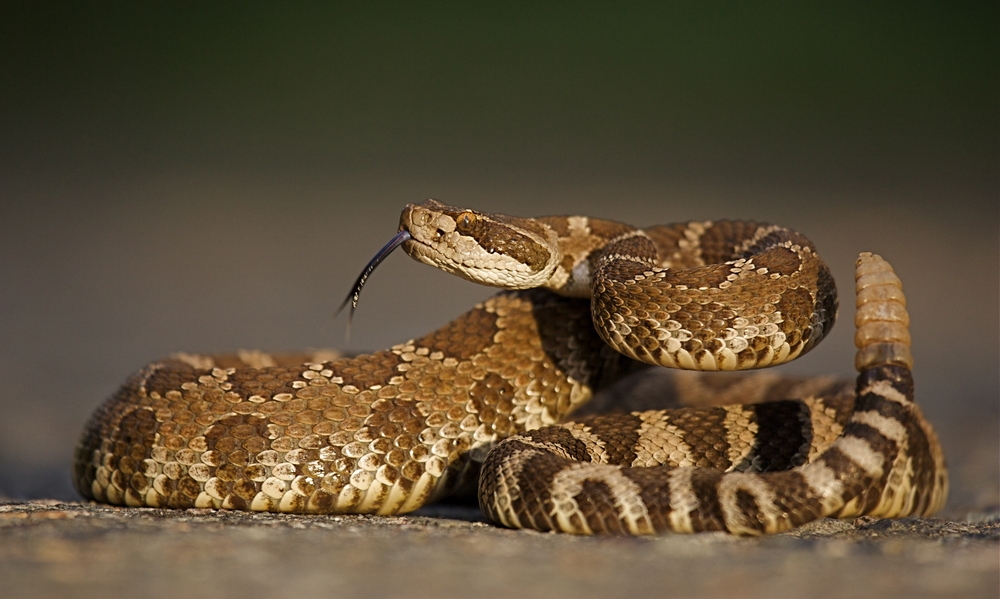
Western Rattlesnakes, also called Prairie Rattlesnakes, are Colorado’s largest and most prevalent rattlesnakes. They are one of the few venomous snake species in Colorado.
An interesting fact about snakes in Colorado is that only the rattlesnake species are venomous.
They tend to shy away from human interaction and only strike if provoked or unintentionally get too close to them. Once they rattle their tail as a warning, stepping a few steps backward slowly might be enough to calm them down.
Western Rattlesnakes are mainly found along the Colorado/Utah border, but you also find them all over the state. They are well adapted to living in almost any habitat type below 9,000 feet (2,734 m).
You can spot them in suburbs, townships, prairies, and desert foothills. They feed on rodents, lizards, rabbits, and ground-dwelling birds.
2. Midget Faded Rattlesnake
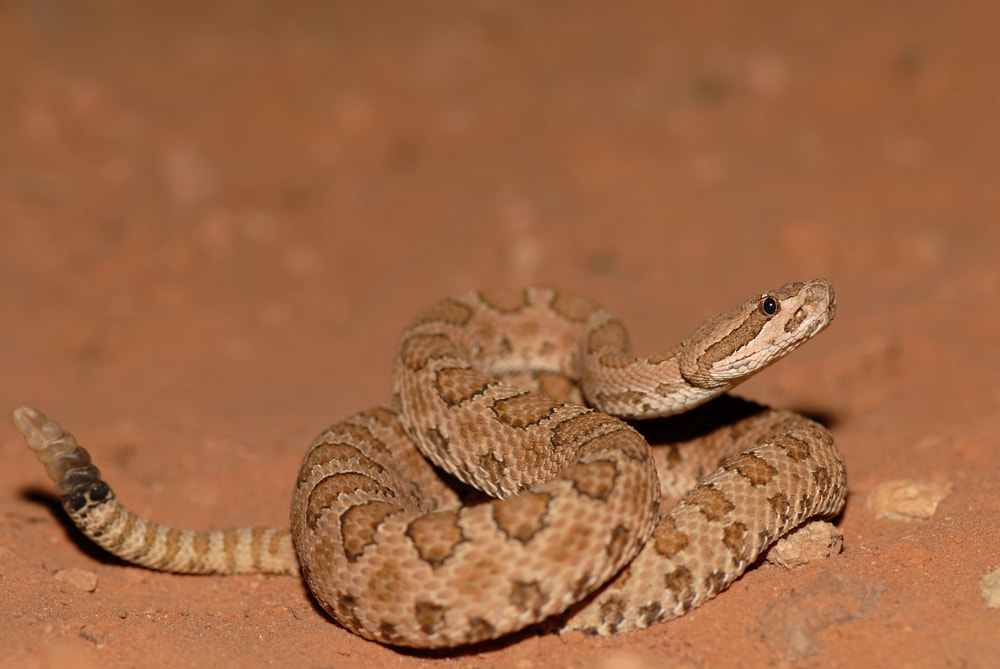
The Midget Faded Rattlesnakes are another venomous snake species endemic to Colorado. They are a smaller subspecies of the Western Rattlesnake, but their venom is far more lethal.
They are also rarer than their cousins and are only found in West-Central Colorado within the Green River formation. They live below 7,000 feet (2133.6 m) and are a challenging species to come by.
They are the smallest species in the Colorado rattlesnake family. They grow up to around 24 inches (60.96 cm), some reaching even 30 inches (76.2 cm).
They are sexually dimorphic. This is where different sexes of the same species exhibit different characteristics that do not include reproduction.
Female Midget Faded Rattlesnakes usually give birth to three or four young ones in mid-August early September every three years.
The snakes feed on lizards, small mammals, and birds and are an essential part of controlling rodent populations in their areas.
3. Smith’s Black-headed Snake

The Smith’s Black-headed snakes are also known as the Southwest Blackhead snakes. They are small nonpoisonous snakes. However, they have some venom to immobilize their invertebrate prey but are considered harmless to humans.
They are one of the smallest snake species in Colorado, only growing to 4.5 to 15 inches (11.43 to 38.1 cm).
They are good burrowers and spend most of their time underground or hidden from other animals. They are active during the night but can also be spotted hunting during the day.
The females lay around three eggs in the summer, hatching in September.
They mainly feed on millipedes, centipedes, and larvae.
4. Blackneck Garter Snake

The Blackneck Garter snakes are found in Southeastern under 6,000 feet (1,828.8 m) and Southwestern under 6,500 feet (1,981.2 m) in colorado. They are named after the black blotches located behind their jaws.
These garter snakes in Colorado grow to about 16 to 28 inches (40 to 71 cm) long. They have a mild form of venom that helps them subdue their prey, but it’s considered harmless to humans.
The Blackneck Gartersnakes release a foul musk from their anal glands when threatened as a means to defend themselves. They also communicate with each other via pheromones and can sense vibrations through their jawbones.
They prefer to live in areas near a consistent water source but can be found in a different kinds of habitats.
Human settlement has pushed them away from their habitats and significantly impacted them. They have to compete for food with other species such as the Bullfrog, which also prey on them.
But the Blackneck Garter snakes’ numbers are high, and their status is of least concern.
5. Common Kingsnake

The Common Kingsnakes are found in remote areas in the Southwest and Southeast of Colorado. Though, they are not easy to spot in the State.
They do not have venom that is dangerous to humans, but they’re known for preying on venomous snakes such as rattlesnakes.
They are slender snakes that grow to about 30 to 42 inches (76 to 107 cm) long. They spend most of their time hidden underground and only emerge to feed. They hunt during the day in wintertime and night in summer.
They feed on other snakes, small mammals, rodents, and lizards. This makes them an essential part of controlling rodent populations in the Colorado region.
Because of their vibrant colors and coy nature, they make for excellent pets and companions.
6. Great Basin Gopher Snake

The Great Basin Gopher snakes can be found in the Western Slope region of Colorado. It is a subspecies of the Bullsnake that lives below 9,000 feet (2743.2 m).
They grow to about 30 to 109 inches (76 to 277 cm). They tend to prefer propagated areas, grass, and brush. Though, you can also find them in desert areas.
They are active during the day but are most active at dawn and dusk. They are among the most commonly spotted snakes on the road and walking trails in Colorado. In spring, males tend to wander around looking for females and fall when young snakes emerge.
The Great Basin Gopher snakes are excellent swimmers, diggers, and climbers, and they can be found anywhere. On top of trees looking for bird eggs, underground seeking shelter from the heat, or in the lakes taking a dip.
7. Common Garter Snake
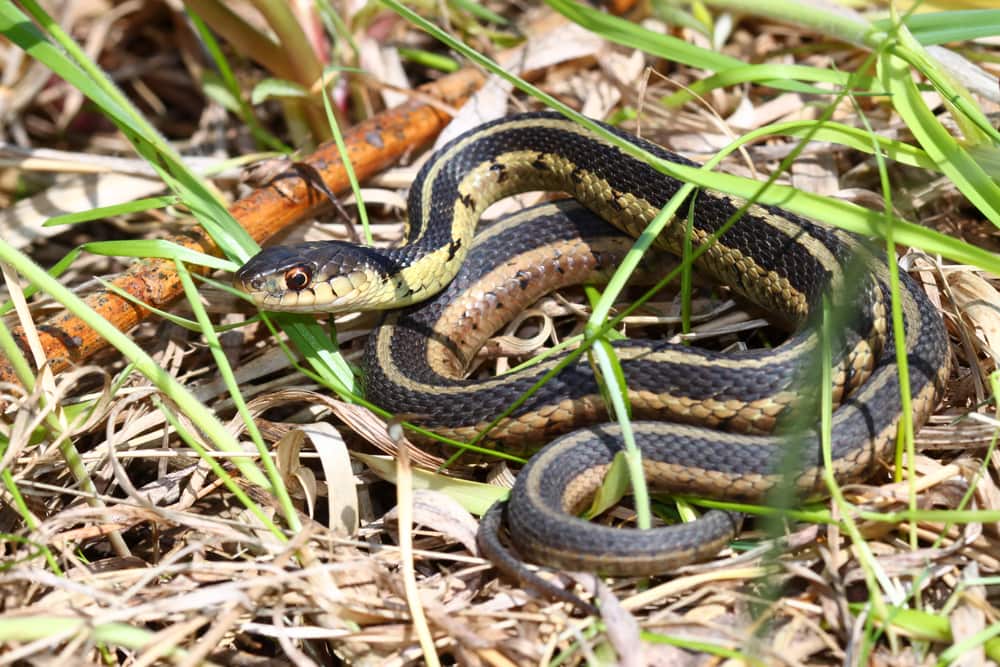
The Common Garter snakes are found in Northern Colorado in flood plains and near streams. They are differentiated from other Garter snakes by their pale stripes and reddish hues on their bodies.
They grow to about 25 to 45 inches (64 to 114 cm) long and are mostly found near water.
Their bite produces an unpleasant reaction in humans, but their venom is not considered deadly. Being bitten by one will give you a bad day, but it will not kill you.
They are excellent swimmers and fishers as well. They are known for diving for fish in lakes and ponds. These small snakes might put you to shame when it comes to fishing.
They like to make for the water when threatened or release a foul musk before striking their aggressors.
They are active during the daytime and feed on amphibians, birds, eggs, small mammals, reptiles, and not forgetting fish.
8. Glossy Snake

The Glossy snakes are also known as Arizona Elegans. They are found under 5,000 feet (1524 m) in the Eastern and extreme Southeastern Colorado.
They are a nonvenomous species and one more reason not to be scared of snakes. Though, they are pretty aggressive and will strike you repeatedly if they deem you a threat. Touche.
They grow to about 30 to 45 inches (76 to 114 cm) long and have a bleached or faded-out appearance.
They are nocturnal by nature and hide underground during the day in existing burrows or dig one out using their noses.
They like arid habitats, grasslands, and rocky washes in the Colorado wilderness.
Glossy snakes feed on lizards, reptiles, small mammals, and terrestrial birds. They kill their prey by constriction or by swallowing them.
Their glossy luster makes them pleasing snakes to look at and make for good pets.
9. Bullsnake

Bullsnakes, also called Gopher snakes, are found in the plains and boulder county of Montane below 9,000 feet (2743.2 m). They are common in grasslands and foothills in colorado. They are a nonvenomous species that is incredibly intimidating because of their size and rattlesnake appearance.
They grow to about 50 to 90 inches (127 to 229 cm) and are one of the largest growing species in Colorado. They are also one of the most common snake species you will find in Colorado, and sightings are not that uncommon.
One misconception about the Bullsnake is that they feed on rattlesnakes, which is false. They rattle like rattlesnakes to ward off threats, but rattlesnakes are not on their menu.
Their prey consists of rodents, rabbits, and squirrels. If you see one, just give it the right of way and don’t panic or run away. It will probably want nothing to do with you.
10. Central Plains Milk Snake

Central Plains Milk snakes are found in Denver and Boulder, Colorado. The most significant numbers of the species are found in areas with limestone rocks and outcroppings. Some do exist in sandy areas but in much smaller numbers.
They grow to about 25 to 35 inches (64 to 89 cm) long. They have a distinctive shape made up of white, red, and black rings along their bodies about four sales wide.
They are most active from March through September and hunt at night time. They are a shy species that like to hide under rocks and burrows.
When captured, they are very uneasy and usually spray a foul musk on their captor’s hands. They also strike their hands or their container. It’s advisable not to approach a Central Plains Milk snake in the wild. Or, if you’re going to keep one as a pet, get training on how to handle it safely.
Though their venom is not painful, their aggression will startle you.
11. Western Ribbon Snake

Western Ribbon snakes are also called Pale milk snakes and are found in some areas of Southeastern Colorado. They are well adapted to agricultural areas.
They grow to about 18 to 34 inches (46 to 86 cm) and are part of the Garter snake group.
To differentiate Western Ribbon snakes from other garter snakes, they have slender bodies and have longer tails. But just like the others, they have a shy persona and are non-venomous.
They have three distinctive stripes running the length of their bodies that are black, brown, and creamy.
When captured, they thrush about aggressively and spray the captor with a musky foul-smelling excretion from their anal gland. They can also break off the ends of their tails to distract predators, but the tails will not grow back in some lizards.
12. Eastern Yellow-Bellied Racer
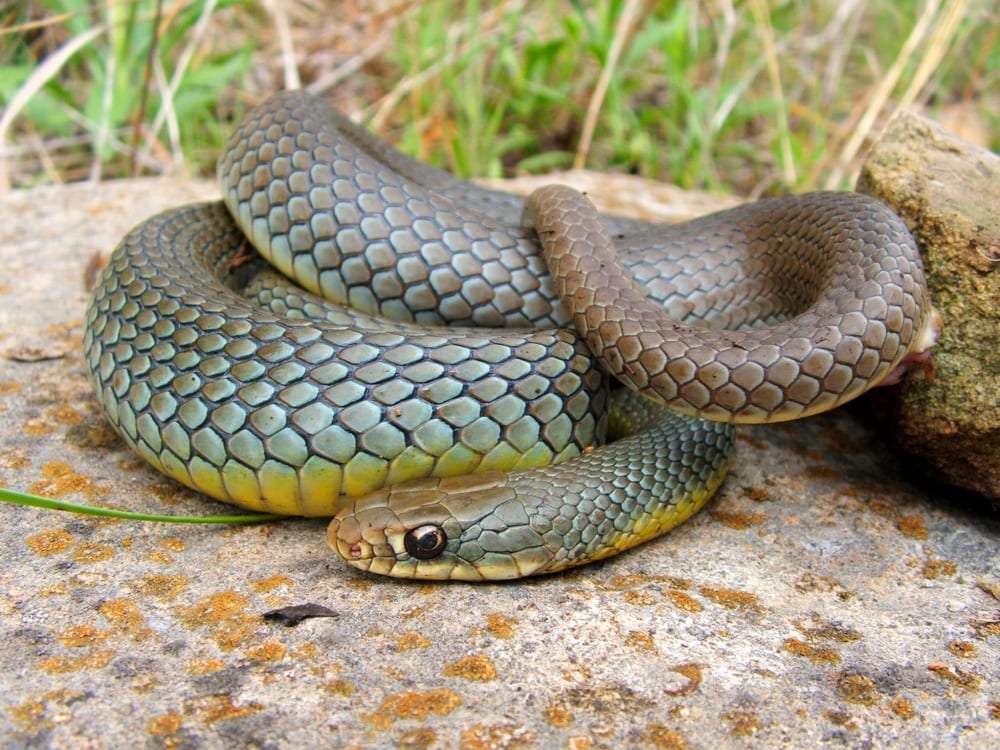
Eastern Yellow-bellied Racers are found in the Eastern parts of Colorado. They are a subspecies of the Eastern Racer, colubrid snake.
They grow up to 24 to 42 inches (61 to 107 cm) long, and as their names suggest, they are pretty fast on land. They are also distinctive from their yellow bellies and brown to teal green hues.
They live in wet areas in Colorado Springs, moshes, and pods.
They are nervous snakes that don’t like being held. They bite anyone trying to hold them and don’t get acclimated to human interaction. They don’t make for good pets.
They feed on worms, amphibians, and small rodents.
13. Western Hognose

Western Hognoses are found in Montane woodlands, but they have also been spotted in suburbs, fields, canyon bottoms, and creosote deserts. They live in areas below 7,874 feet (2400 m). They get their name from the large nose scale present in front of their faces.
Western Hognoses grow to about 15 to 30 inches (38 – 76 cm) long. The males are smaller than the females, but both are heavy-bodied, tame, and timid. They are nonvenomous and tolerant of human handling.
Their extra nose feature makes them good diggers and often burrow holes for shelter. They are active during the day when the sun is not too hot.
When the Western Hognoses are threatened, they flatten their necks much like Cobras and make mock strikes to the intruder. These snakes seldom bite even if you harass them.
14. Western Yellow-bellied Racer

Western Yellow-bellied Racers are also known as Western Racers. They are found in the Northwest and West-central of Colorado. They are related to the Eastern Yellow-bellied Racers, but they are located on the Western side of the Rocky Mountains.
They grow to about 20 to 75 inches (51 to 191 cm) long, and they don’t pose threats to humans because they are nonvenomous.
They are pale brown, grey, or olive-green and have a yellow belly, as their name suggests.
For some time, juvenile Western Yellow-bellied Racers were thought to be a different species because of their drastic differences in blotches from adults. But after further examination, it was discovered they were just younger versions of the same species.
They are active during the day and primarily spend their time on the ground, but they are also good climbers.
15. Northern Watersnake
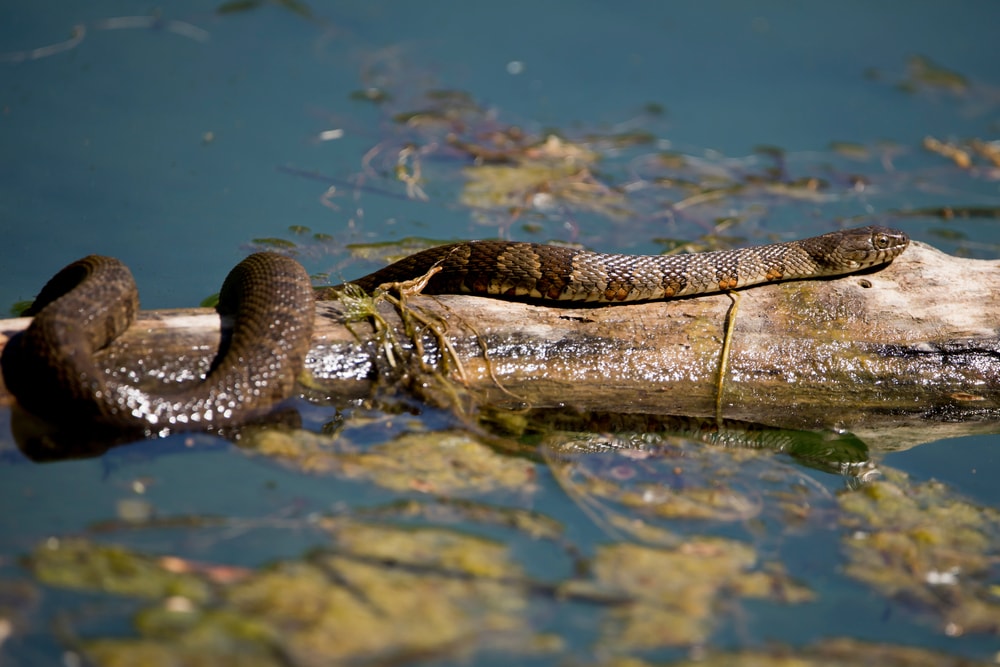
Northern Water Snakes are the only water bound species of snakes in Colorado. They are found in Northeastern and Southeastern parts of Colorado.
They grow to about 35 to 55 inches (89 to 140 cm) long and can be girthy and heavy. They are non-venomous but sometimes mistaken for the venomous Cottonmouth.
Northern Water Snakes are excellent swimmers and fishers.
They make for good pets because they are low-maintenance and don’t require hating as some other species.
They are active both at night in the wild and are mostly sighted at dawn and dusk, basking in the sun.
They mate in April and June. Females give birth to 15 or more young ones usually in August, and birthing might not happen every year.
16. Striped Whipsnake

Striped Whipsnakes are found in the Bryce Canyon. They are not a common snake to spot. These species get their name from their close resemblance to whips. Not very creative, but it works.
They can grow to 36 to 76 inches (91 to 193 cm) long, and their venom is not harmful to humans. They are pretty fast on their feet or, for political correctness, bellies and usually scatter at the first sign of trouble. But if cornered, they strike fiercely.
They have excellent eyesight, which makes them challenging to get close to. They forage with their heads lifted high above the ground, and they might be the only snake species that uses sight more than smell.
They are good climbers, and they move fast from branch to branch or bush to bush as you would in a Ferrari on the streets.
17. Western Massasauga

Western Massasaugas are found in Southern Colorado in Beny, Cheyenne, Ontario, and Kiowa Counties. They like to live in wet prairies, marshes, and areas near rivers and lakes. But they also adapt to drier habitats.
They grow to about 13 to 26 inches (36 to 66 cm) long and are quite thick, and have heads shaped like hearts.
They are pit vipers and quite venomous. Their bite can be lethal to humans, and it’s best to avoid this species. Like other rattlesnakes, they use their rattler to ward off threats, and if it persists, they strike fiercely and are quite precise.
They are a hibernating species and take shelter in other animals’ burrows. Unlike other snake species, they hibernate alone.
18. Long-nosed Snake

Long-Nosed snakes get their name from the long snout present on their noses. They are found in some Southeastern parts of Colorado.
They grow to about 22 to 32 inches (55 to 81 cm) long. They are nocturnal and like to hunt at night when the weather is cooler.
Their unique noses make them experts at digging burrows and will mostly spend their time underground during the day.
It might be a good idea to stay away from Long-nosed snakes, but it’s not for the reasons you think. They are a nonaggressive and nonvenomous species—Yea, a snake that does not want to bite you.
If they feel threatened, they roll around their rattling tails and defecate a foul-smelling odor to ward off threats. Unless you want snake poo on you, we’d suggest staying away from this one.
19. Plains Garter Snake

Plains Garter snakes are found in the freshwaters of prairies and grasslands in Eastern Colorado. They are well adapted to human settlement, and you might spot them in abandoned buildings and parking lots.
They grow to about 16 to 28 inches (41 to 122 cm) long and are differentiated from other Garter snacks by a yellow or orange stripe running down their bodies. And a distinctive black bar on their lip.
These slender snakes have a mild venom they use to subdue their prey, but it’s not considered a threat to humans.
Plain Garter snakes are considered some of the most cold-tolerant snake species that exist. They even come out of their burrows on warm winter days to catch some sun.
They are solitary snakes that hunt and live alone but hibernate in small groups.
20. Texas Blind Snake

Texas Blind snakes are found in Southeastern parts of Colorado. They are coy, digging snakes that like to live in loose, dump soil under boulders. These are probably the smallest snakes you will ever encounter.
They grow to about six to twelve inches (15 to 30 cm) long. No wonder they don’t like to be seen. And just like their name suggests, they are completely blind and move around by feel.
Texas Blind snakes are worm-like in appearance, and you’re likely to mistake them for a worm the first time you see them.
They are also found under building foundations and are more likely to emerge after a rainstorm. Some have been found living in homes’ heating and cooling ducts. One might be living in your home and not even know it.
21. Ringneck Snake

Ringneck snakes can be found in Southeastern Colorado at the bottom of canyons. They are identified by the unique ring of orange scales around their necks and a yellow underbelly.
Ringneck snakes can grow to about 10 to 17 inches (26 to 43 cm) long. The species is nonvenomous and usually doesn’t bite humans.
They are found in various habitats, but they seem to favor moist woodland areas. They are also common in mountainous regions where they take refuge under rocks.
They are active during the day, and like most other small snake species, they tend to spend most of their time hidden and only emerge to feed.
Even though their venom is not considered dangerous to humans, it effectively subdues their prey. This makes Ringneck snakes a perfect choice for a pet snake.
22. Smooth Green Snake

Smooth Green snakes are found all over the Western slope of Colorado. They get their name from their smooth dorsal scale and pure green hue.
They grow to about 14 to 20 inches (36 to 51 cm) long and are nonvenomous.
After hatching, the dorsal scale is not its characteristic green hue. It starts as a blue-grey or even brown but turns to green once the snakes shed their skins for the first time.
Smooth Green snakes live a solitary life and are active both day and night in the warm months. They are excellent climbers, and you can find them hunting for insects on top of trees. They also prefer habitats near water.
Their breeding season is in late spring to early summer, and females start to lay their eggs from June to September.
23. Texas Night Snake

Texas Night Snakes are found in the grasslands and prairies of Colorado. You can also find them in semi-arid habitats that are rocky, full of loose sand and soil.
They grow to be about 10 to 16 inches (25 to 41 cm) long. Their venom is just enough to subdue their prey and is considered non-lethal to humans.
They are nocturnal and sited on roads during the night. The species has vertical elliptical pupils and golden eyes, which may be why they see so well at night.
They feed on other smaller snakes, lizards, and soft-bodied insects. This limited diet makes them a bad choice for a pet. Unless you’re willing to go into the wild to hunt for insects and lizards, you’re probably going to be killing your pet.
24. Great Plains Rat Snake

Great Plains Rat snakes have established a presence in the Southeast and West-Central of Colorado. The species live in grassland, shrubland, and rocky hillsides. They also like to live near sources of water.
They grow to about 40 to 60 inches (102 to 152 cm) long. Their fangs are not large, and venom is not harmful to humans.
Great Plains Rat snakes constrict their prey before eating them whole. They feed primarily on rodents and are essential to controlling rodent populations in Colorado.
The species is nocturnal, and you’re likely to run into one on the road at night as it hunts.
They are a calm species but can be aggressive and bite if provoked.
They like to hibernate in existing burrows, abandoned buildings, and under rocks and boulders.
25. Ground Snake

Another species found in Colorado is the Ground snake or Sonora semiannulata, as it is also known. The species is found throughout the state except for the Northeastern side. Their habitats are mostly grasslands with soil substrates.
They are small-bodied, smooth-scaled, and small-headed snakes that are non-venomous. They grow to be eight to twenty inches(20 to 51 cm) long.
Ground snakes are red and have black bands lining their bodies. Their coy nature and vibrant hues make them great pets and easy to raise.
These species of snakes are also secretive but not rare. They hide during the day and are active during the night.
26. Coachwhip

You can find Coachwhips in Southeastern Colorado under 6,000 feet (1828.8 m). You can also find them in Northeastern Colorado at the Republican River Drainage.
They can grow to about 50 to 80 inches (127 to 203 cm) long. They are one of the largest and fastest snake species found in Colorado.
They have a distinctive pinkish, reddish hue that differentiates them from other species. They get their name from their uncanny resemblance to a whip.
Coachwhips are not venomous, but legend has it that they chase down people and squeeze them hard using their large bodies. They then whip the person with their tails until they’re dead.
They are diurnal, and you can even find them out and about on the hottest of days. They feed on birds, mammals, toads, snakes, and bats.
They can be quite aggressive when cornered and provoked. The snakes tend to strike and bite, making them not the easiest pets for beginner snake pet owners.
27. Western Terrestrial Garter Snake

Western Terrestrial Garter snakes can be found in Colorado’s forests, woodlands, rocky hillsides, and scrublands.
They grow to about 24 to 42 inches (61 to 107 cm) long. The species has a mild venom for subduing their prey, but it’s considered non-toxic for humans.
They are differentiated by yellow dorsal stripes running down both sides of their bodies and blueish underbellies.
The Western Terrestrial Garter snakes are active during the day. Like all other Garter snakes, they also like water. If threatened, they take to the water but don’t spend much time in it like the other species.
They will also release a foul smiling musk to ward off threats and repeatedly strike towards someone who picks them up.
Their diet consists of slugs, fish, amphibians, birds, small mammals, and mice.
28. Lined Snake

Lined snakes are found in the Great Plains of Colorado. Their habitats include grasslands, prairies, and oak forests. You can also find them in the suburbs, vacant lots, and parks.
They grow to about 10 to 18 inches (25 to 46 cm) long. Their mild venom is just for hunting their prey and is not harmful to humans.
Lined snakes are closely related to Garter snakes and are often mistaken for garters. These nocturnal creatures often hide in burrows or under rocks as they wait for the sun to go down.
If threatened, they release a foul musk and try to slither away. They are not very aggressive, but they will strike at you.
The Lined snake is endangered, and conservation efforts are ongoing.
RELATED ARTICLES:

Snakes in Texas | Snakes in Massachusetts | Snakes in Florida | Snakes in PA | Snakes in Georgia | Snakes in Michigan | Snakes in New Hampshire | Snakes in Utah | Snakes in Virginia | Snakes in Tennessee | Snakes in Oklahoma | Rattlesnakes in Arizona








